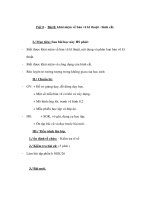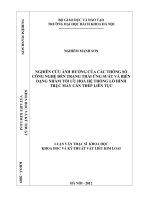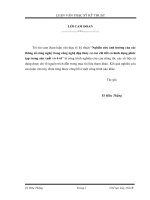Ứng dụng công nghệ ISF gia công mẫu chi tiết vỏ ô tô
Bạn đang xem bản rút gọn của tài liệu. Xem và tải ngay bản đầy đủ của tài liệu tại đây (553.49 KB, 8 trang )
TAẽP CH PHAT TRIEN KH&CN, TAP 14, SO K2 - 2011
APPLYING THE ISF TECHNOLOGY TO PRODUCE THE CAR PART MODELS
Phan Dinh Tuan, Nguyen Thien Binh, Le Khanh Dien, Pham Hoang Phuong
DCSELAB, University of Technology, VNU-HCM
(Manuscript Received on October 21th, 2010, Manuscript Revised January 21st, 2011)
ABSTRACT: The paper presents an application the research results previously done by group
on the influence of technological parameters to the deformation angle and finish surface quality in
order to choose technology parameters for the incremental sheet forming (ISF) process to produce
products for the purpose of rapid prototyping or single-batch production, including all steps from
design and process 3D CAD model, calculate and select the technological parameters, setting up
manufacturing and the stage of post-processing. The samples formed successfully showed high
applicability of this technology to practical work, the complex products with the real size can be
produced in industries: automotive, motorcycle, civil...
Keywords: SPIF, ISF, Single Point Incremental Forming, ISF real-parts
particular, the ISF technology with the
1. INTRODUCTION
Nowadays,
the
sheet
capability of meeting the above requirements is
products in small quantities, but the flexibility
being researched strongly [1]. Although this
in change of design and size is a requirement in
technology is rather new in the world due to the
many fields such as automotive, aviation -
only investment in research for several decades
cosmic,
appliances...
recently, but it has shown its potential
Market needs of rapid prototyping products
development. The advantage of this method is
also require a technology that can meet this
that objects with asymmetric shape can be
demand (Truong Hai Auto Company...): a
produced without using molds, saving time and
technology that can perform in the short term,
costs, can change the product flexibly. Thus,
does not require expensive machines and
the
equipment, the process is simple. Traditional
considerable [6].
medicine,
production
household
of
applicability
of
this
technology
is
methods used in the current industry are hard to
Compared to other methods of forming
meet this demand because the expensive cost of
sheets, this method has the advantage of
mold and other relating equipment. The time to
significantly shortening the production time.
build a die for complex products is quite long
From the computer model, there are two
[5].
additional
processing
steps
conducted:
In recent years, the field of sheet metal
producing the plastic supporter and pressing
deformation was studied and introduced in
plate by using a forming tool mounted on the
order to reduce costs and production time. In
CNC machine... In other words, this method is
Trang 13
Science & Technology Development, Vol 14, No.K2- 2011
capable of forming direct from CAD models on
Thus it is flexible when design changes, the
a computer that does not waste time and costs
forming tool control lines will generate
to produce die and punch as different methods.
automatically to fit.
Figure 1. A sample of producing a sheet model by using ISF
With these advantages, the ISF technology
will bring many benefits to many sectors: civil,
industrial, medical, rapid prototyping and
single – batch production... especially in the
automotive
industry.
Therefore,
the
ISF
technology should be invested in research to
having widespread applications into actual
production. The objective of this paper is to
apply the previous results of research works on
ISF technology at National Key Laboratory of
Digital
Control
and
System
Engineering
(DCSELAB) to create product models, creating
the basis for the production of real parts
corresponding
to
theirs
true
size
and
complexity [2],[3],[4].
2.
PROCESS
OF
SHEET
PRODUCT
FORMING
A process of producing sheet products by
ISF technology is suggested in the Fig. 2 [3]:
Trang 14
Figure 2. Diagram in producing sheet models by
ISF
The detailed steps of procedure are
illustrated in the diagram (Fig. 3):
TAẽP CH PHAT TRIEN KH&CN, TAP 14, SO K2 - 2011
CAD model of designed
product model
Step 1
Step 2
Choosing material
of sheet
Step 3
Choosing diameter
of forming tool
Determining the maximum
forming angle in the model
Checking the maximum
forming limit angle again
To refer to the
Forming Limit
Diagram - FLD
Building the moving
trajectory of forming tool
Creating CAM program in
producing supporter and
pressing sheet (TPIF)
Step 4
Step 5
Producing supporter
on CNC machine
Step 6
Fixing and producing
model (TPIF)
Step 7
Post processing to
complete model
Figure 3. Steps of producing model by ISF
3. APPLICATION METHOD FOR THE
CAR PART PROTOTYPING
The processing model aims to ensure the
largest deformation angle being less than the
3.1. Designing model 3D and processing
forming limit angle of each specific material as
The paper take a car model designed with
specified in [3], reducing the time and ensuring
Autodesk Inventor 2010 (refer to GT model of
Nissan vehicles, Japan) as an example to
introduce the application of this process (Fig.
the technical requirements of the product.
3.2. Work piece, machine, fixture, tool,
lubrication
Sheet material: Aluminum A1050-H14,
4).
1mm in thickness.
Machine: Milling machine 3 axes HASS.
Fixture: Fixture in forming TPIF includes
a platform on which to attach a plate to keep
the supporter and four guide bars are attached
to the substrate. On the four bars, the clamping
Figure 4. 3D Model designed with Autodesk
Inventor
plate slide up and down. The structure of a
TPIF fixture is shown in Fig. 5.
Trang 15
Science & Technology Development, Vol 14, No.K2- 2011
A
A
0
Ø10-0.03
100
100
0
Ø10 -0.03
5 10
15
0.07 A
0.07 A
1.25
1.25
R5±0.01
R2.5±0.01
Figure 6. The forming tool
3.3. Producing plastic supporter
The selection process for producing plastic
supporter based on:
Figure 5. Fixture
-
Technological
parameters
about
Lubrication: Engine oil – grease mixture,
processing characteristics of plastics used as
ratio 3:1. Lubrication appears to be an
the supporter provided by the manufacturer: the
important factor in sheet metal forming. It
melting temperature, the highest cutting speed
reduces friction at the tool-work-piece interface
that the heat generated during the cutting
and improves surface quality.
process does not melt plastic, the strength of
The forming tool: High speed steel
sphere-tip tool with 5mm and 10mm diameter
(Fig. 6).
plastic material...
- The processing capability of 3-axis CNC
milling machine used for processing.
- Requirements to shorten the time when
producing supporter in order to increase
productivity and reduce costs of machine.
Figure 7. Fixture and work-piece fixed on machine table
The Fig. 7 & 8 show a wok-piece fixture and a supporter of car part after producing:
Trang 16
TAẽP CH PHAT TRIEN KH&CN, TAP 14, SO K2 - 2011
Figure 8. Supporter of cars dome
Producing modes by TPIF technology for
3.4. Pressing sheet using CNC machine
To reduce the effect of forming force in
each component of the model are chosen
the z direction, set up wall angle parameter of
according to the results researched in [5], as
0
down line compared with horizontal by 5 .
follows:
Table 1. Choosing the producing parameters [5]
n
Step-
d
Hor
Time
Vxy
(rpm)
down
(m
.Ste
t
(mm/
z
m)
p
(min)
min)
Parts
(mm)
(m
m)
Dome
1000
0.5
5
1
53
1000
Body
1000
0.5
5
1
73
1000
Fender
1000
0.5
5
1
45
1000
Choosing the step-down on the wall (wall
Scallop height) and the step-down on the
Types
Wall scallop height
0,5
Bottom scallop height
0,5
lines being equal on wall sides; the 3D curved
transition
surfaces.
ENGINEER software are:
Value (mm)
The purpose of this set is to create the tool
and
horizontal (bottom Scallop height) with Pro
This
is
The selection process of producing mode
based on:
great
- Reducing speed of spindle (rpm) and
significance for the quality of the product
forming tool (mm/min) to ensure the rigidity of
surface.
the machine;
Trang 17
Science & Technology Development, Vol 14, No.K2- 2011
- Model has many wall surfaces, complex
3D curved surfaces and transitions;
- Increasing step depth to 0.5 mm
compared with the optimal mode [5] in order to
reduce processing time.
Figure 11. Complete model
4. RESULTS
Geometry dimension: in comparison to
CAD model size, using CNC machines to
measure some specific locations on the sample,
we found that the influence of the spring-back
Figure 9. Forming process by TPIF
effect, although there have been compensation
in programming process, still cause a deviation
of about ± 0.8mm (Fig. 12). Such discrepancy
is acceptable for the rapid prototyping process.
We can improve accuracy by calculating the
exact amount of compensation to fabricate
gage and create a reasonable way to run
appliances.
Figure 10. Components of model
3.5. Post-processing and assembly
After producing (Fig. 9), components are
separated from the Aluminum sheet by using a
Figure 12. Checking the contour after producing
cutting tool mounted on CNC machine (Fig.
Surface quality: the theory and actual
10). After that, we polish surfaces used in the
observations after processing showed that the
assembly; connecting parts together; then
"orange peel" phenomenon occurs in low-slope
grinding the welds to ensure the aesthetic
contour. This phenomenon can be over-came if
issues and durability (Fig. 11).
the processing time increases dramatically.
The processing time: is checked and
compared directly on the application software
Trang 18
TAẽP CH PHAT TRIEN KH&CN, TAP 14, SO K2 - 2011
in
the
survey
process.
Processing
and
assembling a complete car model frame require
1.5 days. If we use the stamping method to
create this model, it will take a lot of time for
costs if we could uphold the competitive
advantages:
Able to implement rapid prototyping or
small production series;
processing which includes creating stamping
The process without die;
mold, difficult to produce and time consuming.
Quickly and easily change the size of
Diagram comparing the advantages of two
methods: ISF and stamping from level simple
to complex products [5].
part, enabling high flexibility;
The process does not produce much
noise.
In
practical
production,
the
process
producing the product is very diverse and
abundant; the process technology to create
products contains many research achievements.
Producing with ISF technology will bring high
economic efficiency for the products, which are
produced in small batch, single or rapid
prototyping.
5. CONCLUSIONS
The article introduces a rapid prototyping
Figure 13. The comparison of cost according to the
level of complexity of products between ISF and
stamping [5]
ISF cost depends on the geometry and
sheet-type product process by ISF technology
including all steps from design and process 3D
CAD
model,
calculate
and
technological
parameters,
manufacturing
and
the
select
the
setting
stage
of
up
post-
material of parts. Currently, it shows that, for
processing. The samples formed successfully
moderate complex parts, the model can be
showed high applicability of this technology to
easily produced with ISF. According to these
practical work, the complex products with the
calculations and observations on the chart, we
real size can be produced in industries:
can see that ISF process will be profitable if the
automotive,
number of products is small. If more products
National Key Lab. of Digital Control and
are required, the mass-production methods
System Engineering (DCSE LAB) in HCMC
(such as stamping) will be more profitable [5].
University
Discussion: Investment in ISF technology
will help to maintain and develop the product
conducted
motorcycle,
of
ISF
civil....
Technology
technology
and
has
the
recently
researches
(theoretical, experimental, and application).
lines, supply chains and customers at different
Trang 19
Science & Technology Development, Vol 14, No.K2- 2011
ỨNG DỤNG CÔNG NGHỆ ISF GIA CÔNG MẪU CHI TIẾT VỎ Ô TÔ
Phan Đình Tuấn, Nguyễn Thiên Bình, Lê Khánh Điền, Phạm Hoàng Phương
DCSELAB, Trường Đại học Bách Khoa, ĐHQG-HCM
TÓM TẮT: Bài báo trình bày một quy trình ứng dụng công nghệ biến dạng cục bộ liên tục (ISF)
để tạo hình các sản phẩm dạng tấm với mục đích tạo mẫu nhanh hoặc sản xuất đơn chiếc, bao gồm các
bước từ thiết kế và xử lý mô hình CAD 3D, tính toán và chọn các thông số công nghệ, thiết lập gia công
và giai đoạn xử lý sau gia công, có kế thừa nhiều kết quả nghiên cứu trước đây của nhóm về ảnh hưởng
của các thông số công nghệ đến góc tạo hình và chất lượng bề mặt sau gia công trong phương pháp ISF
để làm cơ sở lựa chọn các thông số công nghệ trong quá trình tạo hình đối với từng sản phẩm cụ thể.
Các mẫu sản phẩm được tạo hình thành công cho thấy tính ứng dụng cao của công nghệ này vào thực
tế có thể gia công các chi tiết phức tạp với kích thước thật trong các nghành công nghiệp xe hơi, xe
máy, dân dụng…
Keywords: SPIF, ISF, Single Point Incremental Forming, ISF real-parts,…
Science - Technology Conference on
REFERENCES
Mechanical Manufacturing Engineering;
[1]. W.C. Emmens, G.Sebastiani, A.H.
van den Boogard; The technology of
Incremental Sheet Forming – A brief
review of the history; Journal of Materials
Processing Technology 210 (2010), p981997.
Le Khanh Dien, et al.; Research on the
forming angle of A1050-H14 aluminum
material
processed
technology;
Journal
by
using
of
Science
SPIF
and
Technology Development – VNU-HCM,
Vol. 12 pp 72-79 (2009).
Phan Dinh Tuan, Nguyen Thien Binh;
Book: Guide for practising the SPIF
Technology; VNU–HCM Publisher; 2010.
Le Khanh Dien, et al.; Research on the
finish surface quality of A1050-H14
aluminum product processed by using
technology;
The
the
2nd
Vietnam
VNU-HCM
Key
Project
2008:
Research on the Dieless Sheet Forming
Technology; 2010.
[6]. Jukka Tuomi, and Lotta Lamminen ;
Incremental Sheet Forming as a Method
for Sheet Metal Component Prototyping
and
[3]. Nguyen Thanh Nam, Phan Dinh Tuan,
Trang 20
[4]. Nguyen Thanh Nam, Le Khanh Dien,
[5]. Nguyen Thanh Nam; Final Report of
[2]. Nguyen Thanh Nam, Phan Dinh Tuan,
SPIF
Hanoi 2009
Manufacturing;
10èmes
Assises
Européennes de Prototypage Rapide – 14
& 15 september 2004.









